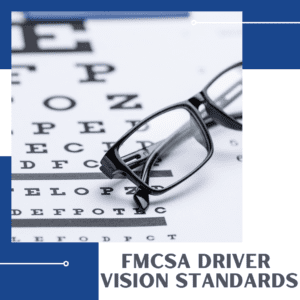FMCSA Issues Final Rule on Driver Vision Standards
The Federal Motor Carrier Safety Administration has published a final rule to permit individuals who do not satisfy, with the worse eye, either the existing distant visual acuity standard with corrective lenses or the field of vision standard or both, to be physically qualified to operate a commercial motor vehicle in interstate commerce under specified conditions. 87 Fed. Reg. 3390 (January 21, 2022).
Currently, such individuals are prohibited from driving CMVs in interstate commerce unless they obtain an exemption from FMCSA. Effective March 22, 2022, the new alternative vision standard replaces the current vision exemption program as the basis for determining the physical qualification of these individuals.
 Before an individual may be medically certified under the alternative vision standard, the individual must have a vision evaluation conducted by an ophthalmologist or optometrist. The ophthalmologist or optometrist records the findings of the visual evaluation and provides specific medical opinions on the new Vision Evaluation Report, Form MCSA–5871. Then, a Medical Examiner performs a physical qualification examination and determines whether the individual meets the alternative vision standard, as well as FMCSA’s other physical qualification standards. If the ME determines the individual meets the physical qualification standards, the ME may issue a Medical Examiner’s Certificate, Form MCSA–5876, for a maximum of 12 months.
Before an individual may be medically certified under the alternative vision standard, the individual must have a vision evaluation conducted by an ophthalmologist or optometrist. The ophthalmologist or optometrist records the findings of the visual evaluation and provides specific medical opinions on the new Vision Evaluation Report, Form MCSA–5871. Then, a Medical Examiner performs a physical qualification examination and determines whether the individual meets the alternative vision standard, as well as FMCSA’s other physical qualification standards. If the ME determines the individual meets the physical qualification standards, the ME may issue a Medical Examiner’s Certificate, Form MCSA–5876, for a maximum of 12 months.
The ME must consider the information in the Vision Evaluation Report and use independent medical judgment to apply four standards. To be physically qualified, the individual must: (1) have, in the better eye, distant visual acuity of at least 20/ 40 (Snellen), with or without corrective lenses, and field of vision of at least 70 degrees in the horizontal meridian; (2) be able to recognize the colors of traffic signals and devices showing standard red, green, and amber; (3) have a stable vision deficiency; and (4) have had sufficient time pass since the vision deficiency became stable to adapt to and compensate for the change in vision.
